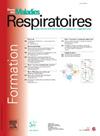病毒诱导的细胞衰老导致流感感染后的肺部后遗症
IF 0.5
4区 医学
Q4 RESPIRATORY SYSTEM
引用次数: 0
摘要
甲型流感病毒(IAV)感染极大地提高了全世界的发病率和死亡率。我们的假设是,呼吸道病毒感染会导致细胞衰老,从而阻碍肺愈合,导致肺气肿和纤维化等长期肺损伤。方法为了研究iav诱导的细胞衰老是否会导致小鼠模型的长期肺损伤,我们采用了药理学、遗传学和免疫标记技术。结果亚致死剂量甲型h1n1流感病毒感染小鼠支气管上皮细胞出现细胞衰老,从感染后第4天开始,到第7天进展到实质细胞衰老。即使在感染后28天,细胞衰老仍在继续;在90 dpi时,它开始下降。肺部显示衰老相关指标,如p16和p21上调以及γ - h2a引发的DNA损伤表达。X.第28天,感染极大地改变了肺的结构和重塑,导致纤维化,气道上皮磨损,肺气肿,支气管和肺泡损伤,特别是在发生衰老细胞积聚的区域。在感染IAV的非人灵长类动物中也发现了类似的结果,其中支气管内的衰老细胞由于气道上皮修复不足而存活。当rapalog AP20187用于消耗p16表达细胞时,p16-ATTAC小鼠的肺纤维化、肺气肿和炎症减少。值得注意的是,气道上皮在损伤后28天完全愈合,证明了上皮修复机制的快速运作。用抗衰老药物ABT-263治疗也能有效地增加上皮修复,但肺气肿和纤维化没有改变。结论病毒引起的细胞衰老是部分肺部流感后遗症的原因。针对衰老细胞的特异性治疗可能是有利的。本文章由计算机程序翻译,如有差异,请以英文原文为准。
Virus-induced cellular senescence causes pulmonary sequelae post-influenza infection
Introduction
The Influenza A virus (IAV) infection dramatically raises rates of morbidity and mortality throughout the world. Our hypothesis is that respiratory viral infections can cause cellular senescence, which can hinder lung healing and lead to long-term lung impairments like emphysema and fibrosis.
Methods
To investigate whether IAV-induced cell senescence results in long-term lung damage in a mouse model, we employed pharmacological, genetic, and immunolabelling techniques.
Results
Cellular senescence was observed in the bronchial epithelia of mice infected with a sublethal dose of IAV H1N1p2009, beginning on day 4 post-infection (dpi) and progressing to the parenchyma on day 7. Even 28 days after infection, cellular senescence persisted; at 90 dpi, it started to decline. The lungs displayed senescence-related indicators, such as upregulated p16 and p21 and DNA damage expression triggered by gamma-H2A. X. On day 28, the infection greatly altered the lungs’ structure and remodeling, resulting in fibrosis, abrasion of the airway epithelium, emphysema, and damage to the bronchi and alveoli, particularly in regions where senescent cell accumulation took place. Similar findings were found in nonhuman primates infected with IAV, where senescent cells within the bronchi survived due to insufficient repair of the airway epithelium. When rapalog AP20187 was used to deplete p16-expressing cells, lung fibrosis, emphysema, and inflammation were reduced in p16-ATTAC mice. Remarkably, the airway epithelium healed completely 28 days following the injury, demonstrating the rapidity with which the epithelial repair mechanism operates. Treatment with the senolytic drug ABT-263 also effectively increases epithelial repair, but emphysema and fibrosis did not change.
Conclusion
The virus-induced cellular senescence responsible for part of the influenza after effects in the lungs. Targeting senescent cells specifically could be advantageous in terms of therapy.
求助全文
通过发布文献求助,成功后即可免费获取论文全文。
去求助
来源期刊

Revue des maladies respiratoires
医学-呼吸系统
CiteScore
1.10
自引率
16.70%
发文量
168
审稿时长
4-8 weeks
期刊介绍:
La Revue des Maladies Respiratoires est l''organe officiel d''expression scientifique de la Société de Pneumologie de Langue Française (SPLF). Il s''agit d''un média professionnel francophone, à vocation internationale et accessible ici.
La Revue des Maladies Respiratoires est un outil de formation professionnelle post-universitaire pour l''ensemble de la communauté pneumologique francophone. Elle publie sur son site différentes variétés d''articles scientifiques concernant la Pneumologie :
- Editoriaux,
- Articles originaux,
- Revues générales,
- Articles de synthèses,
- Recommandations d''experts et textes de consensus,
- Séries thématiques,
- Cas cliniques,
- Articles « images et diagnostics »,
- Fiches techniques,
- Lettres à la rédaction.
 求助内容:
求助内容: 应助结果提醒方式:
应助结果提醒方式:


